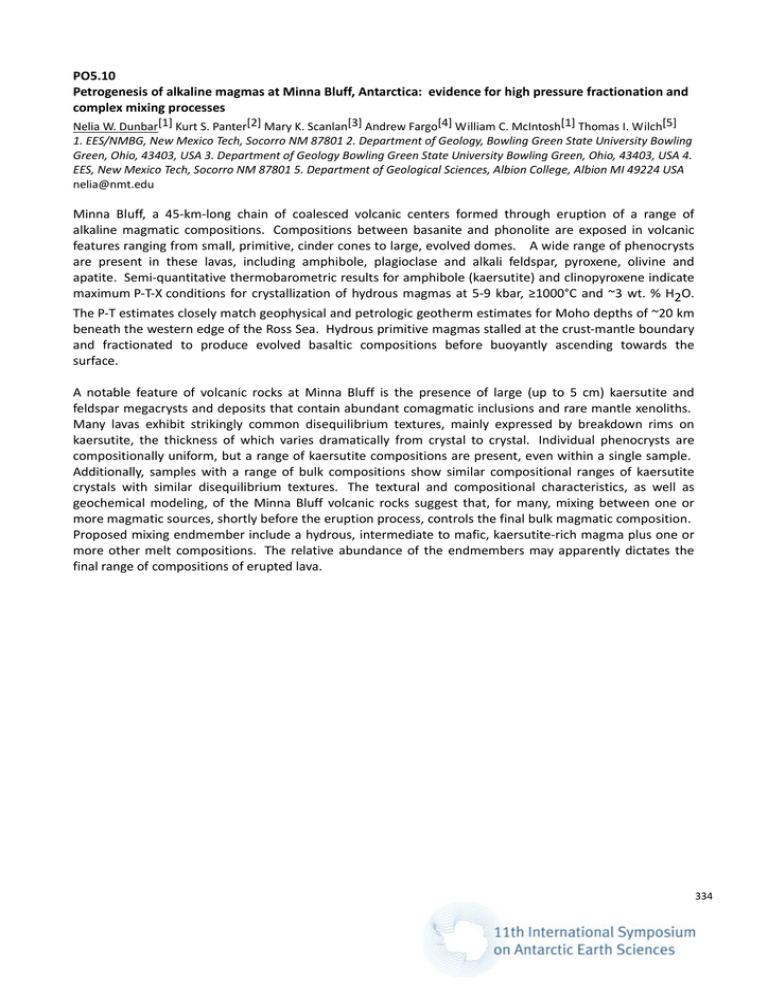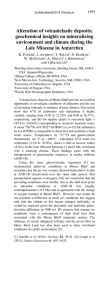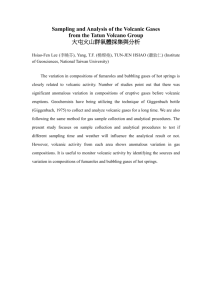Document 10901717
advertisement

PO5.10 Petrogenesis of alkaline magmas at Minna Bluff, Antarctica: evidence for high pressure fractionation and complex mixing processes Nelia W. Dunbar[1] Kurt S. Panter[2] Mary K. Scanlan[3] Andrew Fargo[4] William C. McIntosh[1] Thomas I. Wilch[5] 1. EES/NMBG, New Mexico Tech, Socorro NM 87801 2. Department of Geology, Bowling Green State University Bowling Green, Ohio, 43403, USA 3. Department of Geology Bowling Green State University Bowling Green, Ohio, 43403, USA 4. EES, New Mexico Tech, Socorro NM 87801 5. Department of Geological Sciences, Albion College, Albion MI 49224 USA nelia@nmt.edu Minna Bluff, a 45‐km‐long chain of coalesced volcanic centers formed through eruption of a range of alkaline magmatic compositions. Compositions between basanite and phonolite are exposed in volcanic features ranging from small, primitive, cinder cones to large, evolved domes. A wide range of phenocrysts are present in these lavas, including amphibole, plagioclase and alkali feldspar, pyroxene, olivine and apatite. Semi‐quantitative thermobarometric results for amphibole (kaersutite) and clinopyroxene indicate maximum P‐T‐X conditions for crystallization of hydrous magmas at 5‐9 kbar, ≥1000°C and ~3 wt. % H2O. The P‐T estimates closely match geophysical and petrologic geotherm estimates for Moho depths of ~20 km beneath the western edge of the Ross Sea. Hydrous primitive magmas stalled at the crust‐mantle boundary and fractionated to produce evolved basaltic compositions before buoyantly ascending towards the surface. A notable feature of volcanic rocks at Minna Bluff is the presence of large (up to 5 cm) kaersutite and feldspar megacrysts and deposits that contain abundant comagmatic inclusions and rare mantle xenoliths. Many lavas exhibit strikingly common disequilibrium textures, mainly expressed by breakdown rims on kaersutite, the thickness of which varies dramatically from crystal to crystal. Individual phenocrysts are compositionally uniform, but a range of kaersutite compositions are present, even within a single sample. Additionally, samples with a range of bulk compositions show similar compositional ranges of kaersutite crystals with similar disequilibrium textures. The textural and compositional characteristics, as well as geochemical modeling, of the Minna Bluff volcanic rocks suggest that, for many, mixing between one or more magmatic sources, shortly before the eruption process, controls the final bulk magmatic composition. Proposed mixing endmember include a hydrous, intermediate to mafic, kaersutite‐rich magma plus one or more other melt compositions. The relative abundance of the endmembers may apparently dictates the final range of compositions of erupted lava. 334






